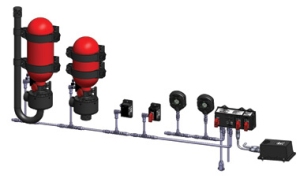 City, transit and school bus systems are a critical component in many communities’ level transportation plans. bus fire suppression systems ensure vehicles and passengers remain safe in case of fire break out. In many communities transit bus plays a major role in providing daily mode of transportation. The impact of a fire in a city or school bus can have ranging impact. few of the issues surrounding bus fires include passenger safety, loss to city or school, loss of passenger capacity, disruption of traffic and public relations issues.Firetrace systems offer a great support to provide fire protection of many of the fire prone areas of these vehicles. A proprietary called red Firetrace Detection Tubing (FDT) which is a heat sensitive polymer tubing which when pressurized, reacts to the heat and radiant energy of a fire by bursting, thus initiating the fire suppression system. Firetrace detection tubing is great for fire detection in buses as it tolerates the vibration, dirt, temperature extremes of the environments in which the buses operate.Firetrace automatic fire suppression system is used
City, transit and school bus systems are a critical component in many communities’ level transportation plans. bus fire suppression systems ensure vehicles and passengers remain safe in case of fire break out. In many communities transit bus plays a major role in providing daily mode of transportation. The impact of a fire in a city or school bus can have ranging impact. few of the issues surrounding bus fires include passenger safety, loss to city or school, loss of passenger capacity, disruption of traffic and public relations issues.Firetrace systems offer a great support to provide fire protection of many of the fire prone areas of these vehicles. A proprietary called red Firetrace Detection Tubing (FDT) which is a heat sensitive polymer tubing which when pressurized, reacts to the heat and radiant energy of a fire by bursting, thus initiating the fire suppression system. Firetrace detection tubing is great for fire detection in buses as it tolerates the vibration, dirt, temperature extremes of the environments in which the buses operate.Firetrace automatic fire suppression system is used
Contributing factors in more than 10,000 buses worldwide. It is also used in thousands of paratransit vehicles, as well as protecting both light and heavy rail.Firetrace systems can be easily fitted to your existing fleet or added to future bus purchases by your personal caretaker or by authorized Firetrace distributors.
Most of the school buses in Australia should have Fire systems compliant to AS5062-2006. Vehicle fire system assures the not only the credibility of vehicles but also the brand.
Contributing factors
Adverse factors like Hydraulic oil contact with hot engine areas, Poor maintenance leading to a buildup of flammable material (lubricant and fuels) near, heat or ignition sources, and Ineffective isolation of ignition sources such as battery terminals.
Recommended control measures to prevent fire incidents include:
- Systematic inspection of all components within a hydraulic or fuel supply circuit during routine part replacements.
- Monitoring of high speed working of hydraulic hoses including checks on hose connections, clamps and pressure relief valves.
- Install a risk based hydraulic hose management system.
- Test and verify internal maintenance systems with additional quality checks by manufacturers or authorised service providers.
- Evaluate isolation techniques such as shielding for potential engine heat sources or insulation of houses near hot components.
- Routine checking of electrical systems for corrosion or insulation fatigue.
- Evaluate the location and rating of protective devices such as fuses and wiring control.
- Install these system on vehicles or plant operating at a higher risk of fire.
- Installing portable fire extinguishers on all mobile plant.
- Provide proper training to all mobile plant staff on hydraulic hazards, fire detection and response procedures.